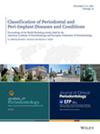上颌前牙骨质撕裂的牙周再生治疗:一项中期队列研究
IF 4.2
2区 医学
Q1 DENTISTRY, ORAL SURGERY & MEDICINE
引用次数: 0
摘要
本队列研究的目的是评估牙釉质基质衍生物(EMD)联合脱蛋白猪骨矿物质(DPBM)对颌骨前牙髓撕裂合并骨内缺损牙周再生治疗的中期临床和影像学结果。方法对41例牙周再生手术患者(平均年龄68.8±11.0岁)进行随访,随访时间为48.3±17.1个月。临床参数,包括探测袋深度(PPD)和临床附着水平(CAL),放射学参数,包括缺陷宽度(DW)和缺陷深度(DD),在基线(T0)、6个月(T1)和最后随访(T2)使用一系列根尖周x线片进行测量。此外,进行Kaplan-Meier生存分析以评估牙骨质撕裂引起的牙齿脱落。结果T1时观察到的明显的临床和影像学改善在T2时保持不变。具体而言,牙周手术联合EMD和DPBM使临床PPD (6.7-4.7 mm)和CAL (7.0-5.2 mm)得到显著改善,DW (1.93-1.52 mm)和DD (6.28-4.47 mm)从T0到T1得到显著改善(p <;0.05)。随访期间仅有4例牙齿脱落,牙齿成活率高达90.2%。结论在本研究的限制范围内,EMD和DPBM联合应用在促进牙周再生和预测上颌前牙髓撕裂合并两壁或三壁骨内缺损患者的牙齿存活方面是有效的。需要进一步严格和精心设计的偏倚对照临床试验来证实这些发现并确定其与临床实践的相关性。牙骨质撕裂是一种罕见但严重的牙齿问题,可导致牙齿脱落,特别是在老年人中。当牙根覆盖层(牙骨质)的一小块脱落时,就会发生这种情况,导致炎症和骨质流失。本研究对41例采用牙釉质基质衍生物和脱蛋白猪骨矿物质进行再生手术治疗的患者进行了随访。在平均4年的时间里,患者在牙龈健康和骨愈合方面表现出显著的改善。牙齿周围的牙袋深度减少,牙龈附着改善,骨缺损减少。重要的是,90.2%的处理过的牙齿存活了下来,显示了该手术的中期有效性。这些发现表明,使用牙釉质基质衍生物和去蛋白猪骨矿物质进行再生手术可能是治疗骨水泥撕裂的成功选择,但需要进一步的研究来完善治疗策略并在更大的患者群体中证实这些结果。本文章由计算机程序翻译,如有差异,请以英文原文为准。
Periodontal regenerative treatment for maxillary anterior cemental tears: A mid‐term cohort study
BackgroundThe aim of this cohort study was to evaluate the mid‐term clinical and radiographic outcomes of periodontal regenerative treatment of maxillary anterior cemental tears associated with intrabony defects using enamel matrix derivative (EMD) in combination with deproteinized porcine bone mineral (DPBM).MethodsForty‐one patients (mean age 68.8 ± 11.0 years) were followed for a mean of 48.3 ± 17.1 months after periodontal regenerative surgery. Clinical parameters, including probing pocket depth (PPD) and clinical attachment level (CAL), and radiographic parameters, including defect width (DW) and defect depth (DD), were measured using serial periapical radiographs at baseline (T0), 6 months (T1), and last follow‐up (T2). In addition, a Kaplan–Meier survival analysis was performed to assess tooth loss due to cemental tears.ResultsThe significant clinical and radiographic improvements observed at T1 were maintained at T2. Specifically, periodontal surgery combining EMD and DPBM resulted in significant clinical improvements in PPD (6.7–4.7 mm) and CAL (7.0–5.2 mm) as well as radiographic improvements in DW (1.93–1.52 mm) and DD (6.28–4.47 mm) from T0 to T1 (p < 0.05). With only four cases of tooth loss recorded during the follow‐up period, a high tooth survival rate of 90.2% was observed.ConclusionsWithin the limitations of the current study, the combination of EMD and DPBM proved effective in promoting periodontal regeneration and predicting tooth survival in patients with maxillary anterior cemental tears associated with two‐wall or three‐wall intrabony defects. Further rigorous and well‐designed bias‐controlled clinical trials are needed to confirm these findings and determine their relevance to clinical practice.Plain Language SummaryCemental tears are a rare but serious dental issue that can lead to tooth loss, especially in older adults. They occur when a small piece of the tooth's root covering (cementum) breaks away, causing inflammation and bone loss. This study followed 41 patients who received regenerative surgical treatment using enamel matrix derivative and deproteinized porcine bone mineral to repair the damage. Over an average of 4 years, patients showed significant improvements in gum health and bone healing. Pockets around the teeth were reduced in depth, gum attachment improved, and bone defects decreased. Importantly, 90.2% of the treated teeth survived, showing the procedure's mid‐term effectiveness. These findings suggest that regenerative surgery using enamel matrix derivative and deproteinized porcine bone mineral can be a successful option for treating cemental tears, but further research is needed to refine treatment strategies and confirm these results in larger patient groups.
求助全文
通过发布文献求助,成功后即可免费获取论文全文。
去求助
来源期刊

Journal of periodontology
医学-牙科与口腔外科
CiteScore
9.10
自引率
7.00%
发文量
290
审稿时长
3-8 weeks
期刊介绍:
The Journal of Periodontology publishes articles relevant to the science and practice of periodontics and related areas.
 求助内容:
求助内容: 应助结果提醒方式:
应助结果提醒方式:


